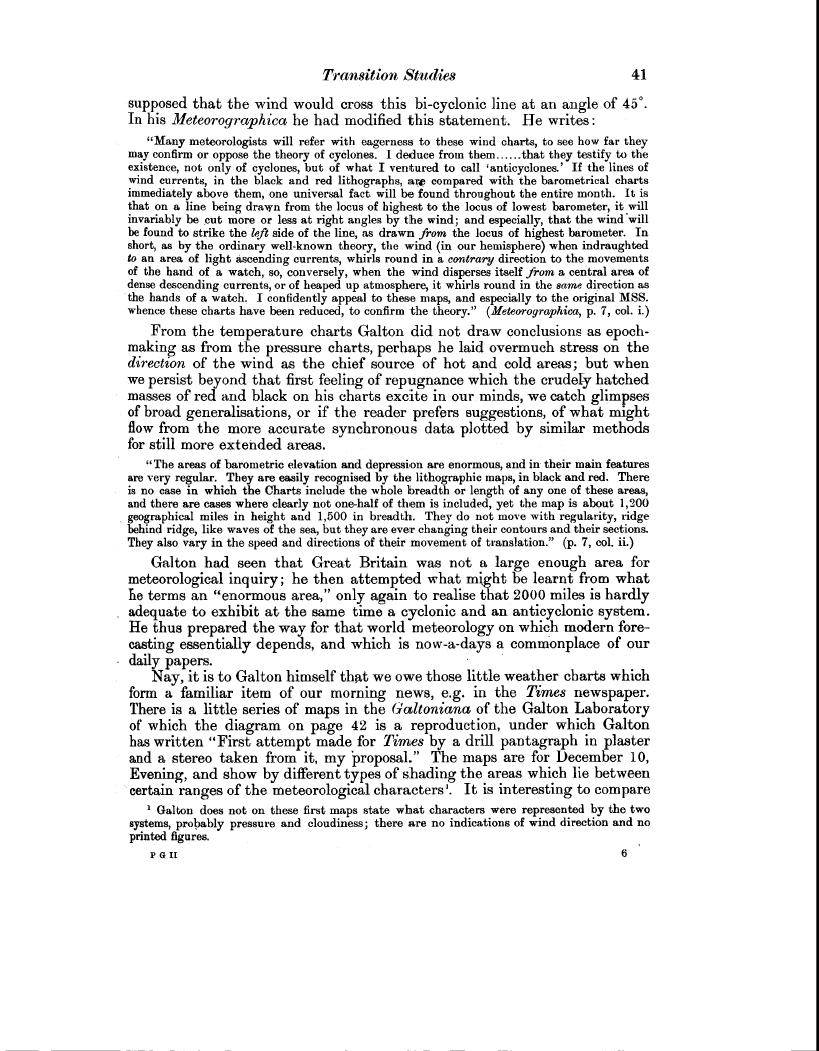Transition Studies 41
supposed that the wind would cross this bi-cyclonic line at an angle of 45°. In his Meteorographica he had modified this statement. He writes
"Many meteorologists will refer with eagerness to these wind charts, to see how far they may confirm or oppose the theory of cyclones. I deduce from them that they testify to the existence, not only of cyclones, but of what I ventured to call 'anticyclones.' If the lines of wind currents, in the black and red lithographs, arc compared with the barometrical charts immediately above them, one universal fact, will be found throughout the entire month. It is that on a line being drawn from the locus of highest to the locus of lowest barometer, it will invariably be cut more or less at right angles by the wind; and especially, that the wind will be found to strike the left side of the line, as drawn from the locus of highest barometer. In short, as by the ordinary well-known theory, the wind (in our hemisphere) when indraughted to an area of light ascending currents, whirls round in a contrary direction to the movements of the band of a watch, so, conversely, when the wind disperses itself from a central area of dense descending currents, or of heaped up atmosphere, it whirls round in the same direction as the hands of a watch. I confidently appeal to these maps, and especially to the original MSS. whence these charts have been reduced, to confirm the theory." (Meteorographica, p. 7, col. i.)
From the temperature charts Galton did not draw conclusions as epochmaking as from the pressure charts, perhaps he laid overmuch stress on the direction of the wind as the chief source of hot and cold areas; but when we persist beyond that first feeling of repugnance which the crudely hatched masses of red and black on his charts excite in our minds, we catch glimpses of broad generalisations, or if the reader prefers suggestions, of what might flow from the more accurate synchronous data plotted by similar methods for still more extended areas.
"The areas of barometric elevation and depression are enormous, and in their main features are very regular. They are easily recognised by the lithographic maps, in black and red. There is no case in which the Charts include the whole breadth or length of any one of these areas, and there are cases where clearly not one-half of them is included, yet the map is about 1,200 geographical miles in height and 1,500 in breadth. They do not move with regularity, ridge behind ridge, like waves of the sea, but they are ever changing their contours and their sections. They also vary in the speed and directions of their movement of translation." (p. 7, col. ii.)
Galton had seen that Great Britain was not a large enough area for meteorological inquiry ; he then attempted what might be learnt from what he terms an "enormous area," only again to realise that 2000 miles is hardly adequate to exhibit at the same time a cyclonic and an anticyclonic system. He thus prepared the way for that world meteorology on which modern forecasting essentially depends, and which is now-a-days a commonplace of our daily papers.
Nay, it is to Galton himself that we owe those little weather charts which form a familiar item of our morning news, e.g. in the Times newspaper. There is a little series of maps in the Galtoniana of the Galton Laboratory of which the diagram on page 42 is a reproduction, under which Galton has written "First attempt made for Times by a drill pantagraph in plaster and a stereo taken from it, my proposal." The maps are for December 10, Evening, and show by different types of shading the areas which lie between certain ranges of the meteorological characters'. It is interesting to compare
' Galton does not on these first maps state what characters were represented by the two systems, probably pressure and cloudiness; there are no indications of wind direction and no printed figures.
Paii

